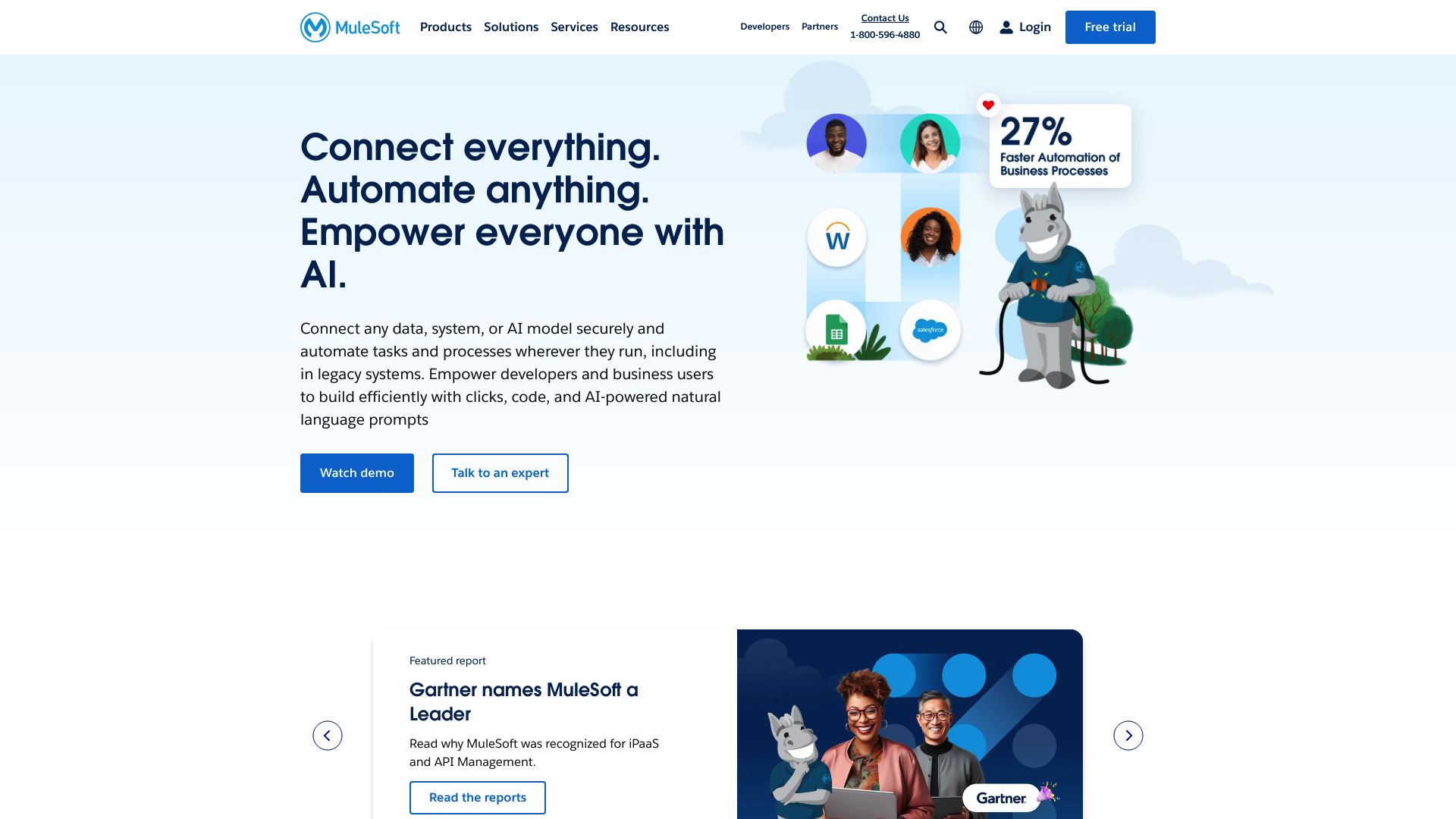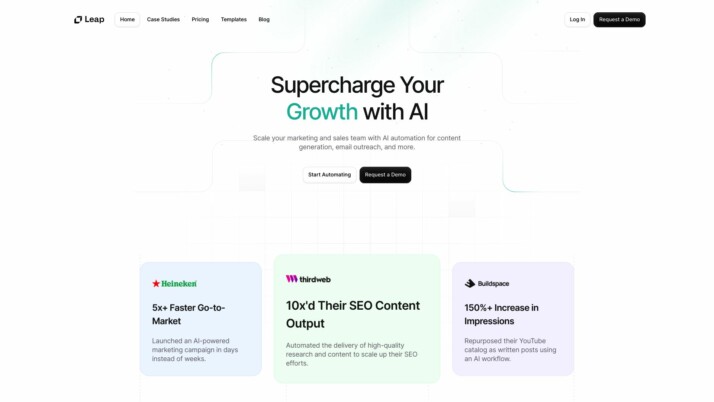Mulesoft vs. Leap AI: Enterprise vs. User-Friendly AI Integration
AI technologies revolutionize business processes, but choosing the right platform remains crucial for success. This comparison explores MuleSoft vs. Leap AI, and SmythOS, three distinct solutions for AI integration and workflow automation. MuleSoft offers enterprise-grade capabilities with robust API management, while Leap AI simplifies AI workflow creation through a user-friendly interface.
SmythOS emerges as a powerful alternative, combining ease of use with advanced features. We’ll examine each platform’s strengths, limitations, and ideal use cases, empowering readers to make informed decisions about integrating AI into their operations.
Mulesoft Overview
Mulesoft provides a comprehensive integration platform designed to connect applications, data, and devices across on-premises and cloud environments. The Anypoint Platform enables organizations to design, build, and manage APIs and integrations, facilitating digital transformation initiatives.


MuleSoft’s API-led connectivity approach allows businesses to create reusable assets, enhancing development efficiency and security. The platform integrates AI capabilities, including Einstein AI, to streamline project initiation and boost developer productivity. Anypoint Studio, a visual development environment, simplifies API and integration design for technical and non-technical users alike.
MuleSoft’s API-led connectivity approach allows businesses to create reusable assets, enhancing development efficiency and security.
The Anypoint Platform offers full-lifecycle API management, encompassing design, development, deployment, and monitoring. MuleSoft’s Flex Gateway ensures secure API management, crucial for AI and data integration efforts. The platform supports various deployment options, including CloudHub, on-premises runtimes, and Kubernetes-based solutions.
MuleSoft’s integration with AI models like OpenAI enables advanced use cases such as chatbots and automated workflows. The platform maintains context through conversation history and object stores, enhancing AI-driven interactions. While MuleSoft excels in enterprise integration and API management, it may require significant technical expertise for complex implementations.
MuleSoft’s scalability and robust security features position it well for large-scale enterprise deployments. The platform’s extensive integration capabilities with various data types, services, and AI models make it suitable for diverse industry applications. However, smaller organizations or those seeking simple AI agent deployments might find MuleSoft’s extensive feature set overwhelming.
Leap AI Overview
Leap AI empowers users to create sophisticated AI workflows without coding expertise. The platform’s drag-and-drop interface allows rapid development of AI-powered applications, from blog post generators to lead summarizers. Leap AI supports integration with popular AI models like OpenAI GPT and Stable Diffusion XL, enabling diverse tasks such as text generation, image creation, and music production.


Leap AI empowers users to create sophisticated AI workflows without coding expertise. The platform’s drag-and-drop interface allows rapid development of AI-powered applications…
Developers benefit from Leap AI’s comprehensive SDK support, offering RESTful API, TypeScript, and Python options for seamless integration. The platform’s extensive template library accelerates the creation of AI applications, while its user-friendly dashboard facilitates easy workflow design and execution. Leap AI also provides tools for fine-tuning and training custom models, enhancing AI output specificity and accuracy.
Leap AI seamlessly integrates with widely-used tools including Slack, Hubspot, Zendesk, and Microsoft Power Platform. This interoperability extends the platform’s utility across various business processes. While Leap AI offers powerful features for AI workflow creation, users should consider potential limitations in scalability for enterprise-level deployments and the depth of customization available compared to more specialized tools.
Leap AI positions itself as a democratizing force in AI technology, aiming to make advanced capabilities accessible to a broader audience.
Leap AI positions itself as a democratizing force in AI technology, aiming to make advanced capabilities accessible to a broader audience. The platform’s focus on no-code solutions opens doors for non-technical users to leverage AI for task automation and innovation. However, experienced developers may find the visual interface constraining for highly complex, custom AI implementations.
In the competitive landscape of AI agent builders, Leap AI stands out for its user-friendly approach and diverse model support. The platform’s strength lies in rapid prototyping and deployment of AI workflows, making it particularly suitable for small to medium-sized businesses and individual developers looking to quickly implement AI solutions without deep technical expertise.
Feature Comparison
Mulesoft and Leap AI offer distinct approaches to AI integration and workflow automation. Mulesoft excels in enterprise-grade integration capabilities, providing robust API management and data connectivity across diverse systems. Its Anypoint Platform enables full-lifecycle API management, from design to deployment and monitoring. In contrast, Leap AI focuses on simplifying AI workflow creation through a user-friendly, no-code interface.
Mulesoft’s strength lies in its comprehensive security features and scalability, crucial for large-scale enterprise deployments. The platform offers advanced features like Anypoint Flex Gateway for secure API management and Einstein AI integration for enhanced developer productivity. However, Leap AI stands out with its extensive template library and support for various AI models, making it more accessible for rapid AI application development without deep technical expertise.
While both platforms support integration with external tools and services, Mulesoft’s offering is more extensive, catering to complex enterprise needs. Leap AI, on the other hand, provides a more streamlined approach to AI workflow creation, potentially sacrificing some of the depth and customization options available in Mulesoft for ease of use and quick deployment.
Feature Comparison Table
| Mulesoft | Leap AI | SmythOS | |
|---|---|---|---|
| CORE FEATURES | |||
| Hosted Agents (Dev, Production) | ✅ | ❌ | ✅ |
| Memory & Context | ❌ | ✅ | ✅ |
| Autonomous Agents | ✅ | ❌ | ✅ |
| Explainability & Transparency | ❌ | ❌ | ✅ |
| Debug Tools | ✅ | ❌ | ✅ |
| Problem-Solving Capabilities | ❌ | ✅ | ✅ |
| Multi-Agent Collaboration | ✅ | ❌ | ✅ |
| Human-AI Interaction | ❌ | ✅ | ✅ |
| Audit Logs for Analytics | ❌ | ✅ | ✅ |
| SECURITY | |||
| Constrained Alignment | ✅ | ❌ | ✅ |
| Data Encryption | ❌ | ✅ | ✅ |
| COMPONENTS | |||
| Huggingface AIs | ❌ | ✅ | ✅ |
| Zapier APIs | ❌ | ✅ | ✅ |
| All other APIs, RPA | ❌ | ✅ | ✅ |
| Logic | ❌ | ✅ | ✅ |
| Data Lakes | ✅ | ❌ | ✅ |
| DEPLOYMENT OPTIONS (EMBODIMENTS) | |||
| Deploy as Scheduled Agent | ❌ | ✅ | ✅ |
| Scalability | ❌ | ✅ | ✅ |
| DATA LAKE SUPPORT | |||
| Hosted Vector Database | ✅ | ❌ | ✅ |
| Sitemap Crawler | ❌ | ✅ | ✅ |
| YouTube Transcript Crawler | ❌ | ✅ | ✅ |
| URL Crawler | ❌ | ✅ | ✅ |
| PDF Support | ❌ | ✅ | ✅ |
Best Alternative to Mulesoft and Leap AI
SmythOS emerges as the superior alternative to Mulesoft and Leap AI, offering a comprehensive agentic AI automation platform that combines the best of both worlds. Our platform delivers unparalleled ease of use, an extensive feature set, and unlimited use cases, making it the ideal choice for businesses seeking powerful AI solutions.
Unlike Mulesoft’s complex enterprise integration focus or Leap AI’s simplified no-code approach, SmythOS provides a perfect balance of power and accessibility. We offer a visual builder that simplifies AI agent creation without sacrificing advanced capabilities. This allows both technical and non-technical users to create sophisticated AI workflows tailored to their specific needs.
SmythOS provides a perfect balance of power and accessibility… allowing both technical and non-technical users to create sophisticated AI workflows tailored to their specific needs.
SmythOS stands out with its robust set of features that address critical gaps in both Mulesoft and Leap AI. Our platform supports hosted agents for development and production environments, ensuring seamless deployment across different stages. We also offer advanced memory and context management, enabling AI agents to maintain long-term knowledge and adapt to complex scenarios. These capabilities are essential for creating truly intelligent and autonomous agents, something neither Mulesoft nor Leap AI fully achieves.
One of SmythOS’s key advantages is its flexibility and scalability. While Mulesoft excels in enterprise-grade integrations and Leap AI focuses on rapid AI application development, SmythOS combines both strengths. We provide extensive API integrations and support for various AI models, allowing users to connect to diverse data sources and leverage cutting-edge AI technologies. This versatility enables businesses to create AI solutions that can grow and evolve with their needs, from simple chatbots to complex multi-agent systems handling enterprise-wide tasks.
SmythOS combines both strengths… allowing users to connect to diverse data sources and leverage cutting-edge AI technologies.
By choosing SmythOS, businesses gain access to a platform that not only meets their current AI automation needs but also positions them for future innovation. Our commitment to continuous improvement and user-centric design ensures that SmythOS will remain at the forefront of AI technology, providing a competitive edge in an increasingly AI-driven world.
Conclusion
Mulesoft and Leap AI offer powerful solutions for AI integration and workflow automation, each with distinct strengths. Mulesoft excels in enterprise-grade integration and API management, providing robust security and scalability for large-scale deployments. Its comprehensive Anypoint Platform and Einstein AI integration cater to complex enterprise needs. Leap AI, conversely, shines in its user-friendly approach to AI workflow creation, offering a no-code interface and extensive template library that democratizes AI technology for a broader audience.
While both platforms have their merits, SmythOS emerges as the superior choice, combining the best of both worlds. SmythOS offers a powerful drag-and-drop interface for creating sophisticated AI workflows, rivaling Leap AI’s ease of use. Simultaneously, it provides enterprise-grade features like multi-agent orchestration, extensive API integrations, and versatile deployment options that match or exceed Mulesoft’s capabilities.
SmythOS stands out with its “Create Once, Deploy Anywhere” approach, allowing seamless integration across various platforms and services. This flexibility, combined with support for multiple AI models and a vast integration ecosystem of over 300,000 connections, positions SmythOS as the most versatile and capable solution for businesses of all sizes.
For those looking to harness the full potential of AI in their workflows, we invite you to explore SmythOS’s diverse range of AI-powered agent templates. These templates cover multiple business categories and offer a perfect starting point for your AI journey. To experience the power of SmythOS firsthand, create a free SmythOS account and start building AI agents with no time limit or risk. Unlock the future of workforce automation and revolutionize your business processes with SmythOS today.
Last updated:
Disclaimer: The information presented in this article is for general informational purposes only and is provided as is. While we strive to keep the content up-to-date and accurate, we make no representations or warranties of any kind, express or implied, about the completeness, accuracy, reliability, suitability, or availability of the information contained in this article.
Any reliance you place on such information is strictly at your own risk. We reserve the right to make additions, deletions, or modifications to the contents of this article at any time without prior notice.
In no event will we be liable for any loss or damage including without limitation, indirect or consequential loss or damage, or any loss or damage whatsoever arising from loss of data, profits, or any other loss not specified herein arising out of, or in connection with, the use of this article.
Despite our best efforts, this article may contain oversights, errors, or omissions. If you notice any inaccuracies or have concerns about the content, please report them through our content feedback form. Your input helps us maintain the quality and reliability of our information.
